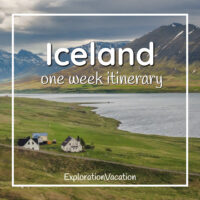Last updated on May 5th, 2021
Are you looking for the best whale watching in Iceland? Head north for a puffin and whale watching tour in Husavik! But first, keep reading to see what to expect and how to find and book the best tour for you.

Keep reading or jump ahead to the info you need most:
Watching puffins and whales on Iceland’s north coast
Where is the best whale watching in Iceland?
• Why Husavik is the best place for whale watching
Plan your Husavik whale watching trip
• How do I get to Husavik?
• When is the best time for whale watching in Husavik?
• Husavik whale watching tour companies
• Choose the right tour for you
• Support responsible whale watching and tourism
• Booking your tour
• The day of your tour
Watching puffins and whales on Iceland’s north coast
I took a puffin and whale watching tour in Husavik in June, 2018.
Our tour with North Sailing was scheduled for 8:30 am. That’s not particularly early for Iceland, where the summer sun barely dips below the horizon. By the time I arrive at the harbor, the sun is already well above the horizon, if hidden by clouds.
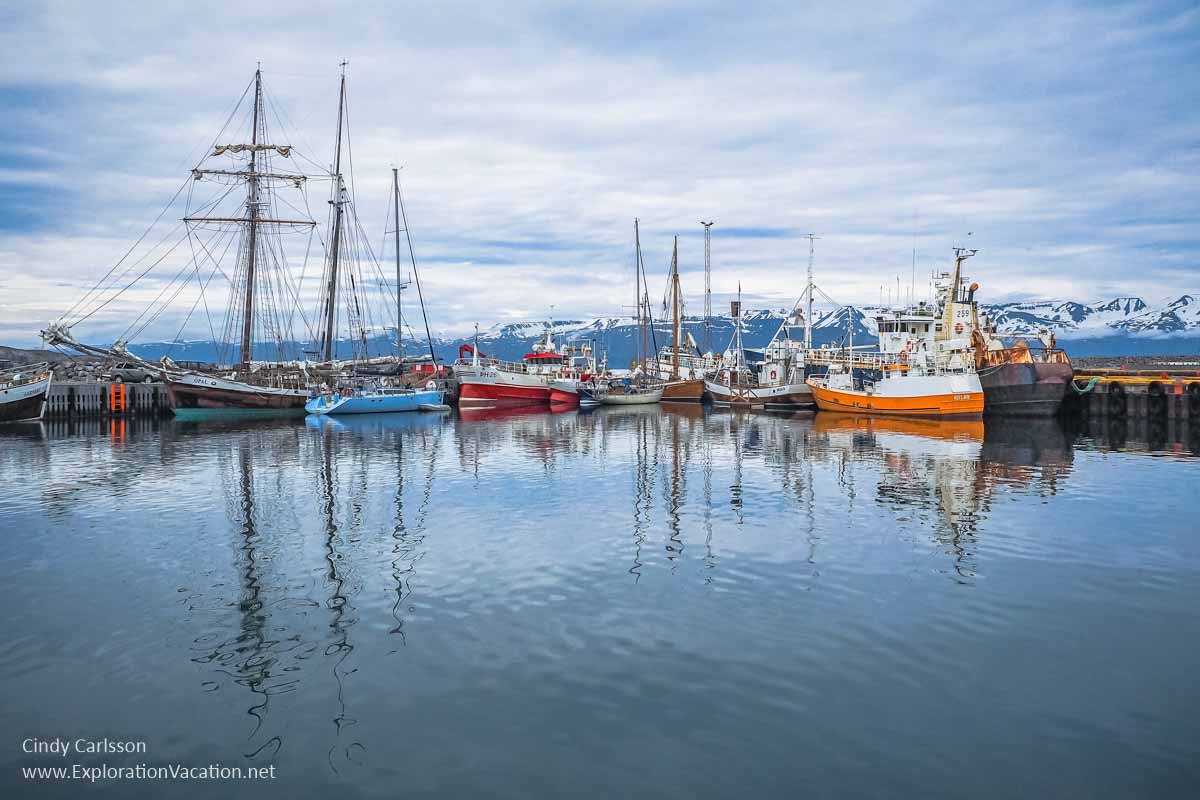
We’d allowed plenty of time to check in for our tour, so there is time to walk along the harbor and check out Husavik’s mix of boats. And it is a mix. There are working fishing boats, personal boats of all types, and variety of whale watching boats. There are even a few tall ships. Wouldn’t it be fun to go out on one of those!
Tall ship vs traditional fishing boat
I could have booked my whale watching tour on a tall ship. I wanted to.
And now, seeing them in the harbor, it’s hard not to question my decision to book a tour on motorized former fishing boat instead.

Still, I’m enthralled by the idea of watching whales leap while gliding along under sail.
But I’ve sailed on tall ships before and I’ve gone whale watching more than once as well. Those experiences left me with rather low (or maybe just realistic) expectations for whale watching from a vessel designed for sailing. Even under engine power, it’s just not as efficient as a boat designed for motoring. Don’t get me wrong, being on a tall ship is lots of fun and you’ll likely see whales. It’s just not the most practical option for observing, let alone photographing, wildlife.
So, instead of traveling with the wind on a tall ship, I’ll be spending the morning on the Sæborg, a motorized oak fishing boat repurposed for whale watching.
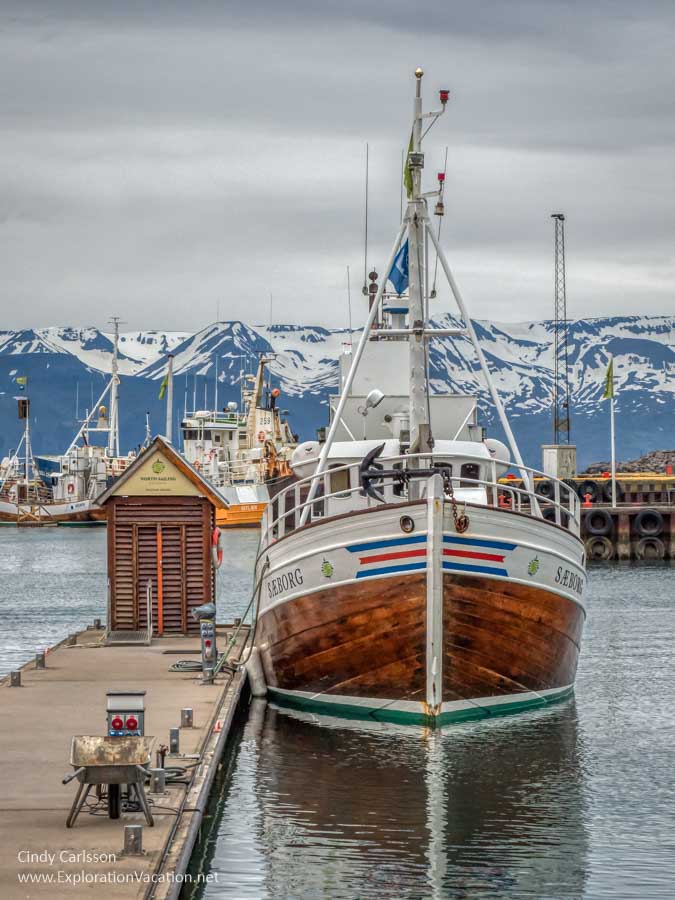
Not that Sæborg isn’t attractive in its own way. These oak boats have long been used by Icelandic fisherman, and their practical blend of form and function has its own beauty. And, like the schooners, the Sæborg was lovingly restored.
But, most importantly, as a whale watching boat, Sæborg offers advantages over those showy schooners.
While a schooner is lovely for a sightseeing sail, a motorized fishing boat offers additional speed and flexibility to get to wherever the whales may be on any given day. Moving around on deck is also easier, with more options for getting a good view without dodging rigging or other equipment. And then there’s the fact that I’m susceptible to sea sickness, so a motorized boat that with more stability is a better bet should seas turn rough.
(All of which were good assumptions, based on my friend Rachel’s whale watching tour on a schooner on a not very pleasant day.)
But let’s be honest. Puffins made me book a tour on a former fishing boat. I would have booked a tour on any boat if it promised puffin sightings. North Sailing only offers its puffins and whales tour on oak fishing boats, so that’s what I booked. After all, I want to see puffins as much as I want to see whales.
On board the Sæborg
Whale watchers are always warned to dress more warmly than seems necessary, as it is colder on the water beyond the harbor. But we were also issued a pair of well insulated overalls and a bright red Arctic expedition-worthy jacket. These extra layers would us stay warm and dry out in the bay, although I suspect the real purpose is to make it easy to spot anyone that somehow manages to go overboard.

At just over 60 feet long and 15 feet across, Sæborg is a mid-sized member of Husavik’s fleet of wooden whale watching tour boats. North Sailing’s own fleet includes both larger and smaller motor boats and schooners. She can carry up to 70 passengers.
I have no idea how many passengers are on our tour, but I am quite sure it’s not 70. It’s about the right number though, enough that North Sailing should be able to stay in business, but not enough to feel crowded. It seems that, with just a bit of jostling, everyone can stand along the rail in the large open bow if they want. But there is also an open deck above the captain’s small cabin (ideal for spotting whales in the distance) and plenty of space in the stern (which offers some protection from the wind).
The bow has a couple of benches in the middle, but I am sure I will spend most of my time standing in the bow looking for birds and whales.
The crew includes a very knowledgeable South American naturalist to explain what we are seeing, spot wildlife (everyone helps spot wildlife), and answer questions. But, in reality, all of the crew was knowledgeable and very familiar with the area and its wildlife.
In the shadow of Puffin Island
My husband warned me not to get too excited about Puffin (Lundey) Island. After all, it’s a nesting area, so we won’t be going ashore, nor are we likely to get really close to the island. (This is not the Galapagos, where you go ashore and try not to trip over birds sitting on the trail!) And puffins are small birds.
All of which I knew.
Even so, viewing birds on the island is harder than I anticipated.

We get close enough to see the entire island seems covered with puffins and other birds. But we don’t actually circle the island and, from where we float, it is deeply shaded as the sun begins to break through the clouds on the opposite side of the island. That makes both the birds on land and in the water right around it very hard to see and impossible to photograph.
Of course, puffins are small enough that it can be hard to get a good look at them even from the deck of a relatively small boat like the Sæborg. But it is amazing to see thousands of them all around, both on the water and in the air.
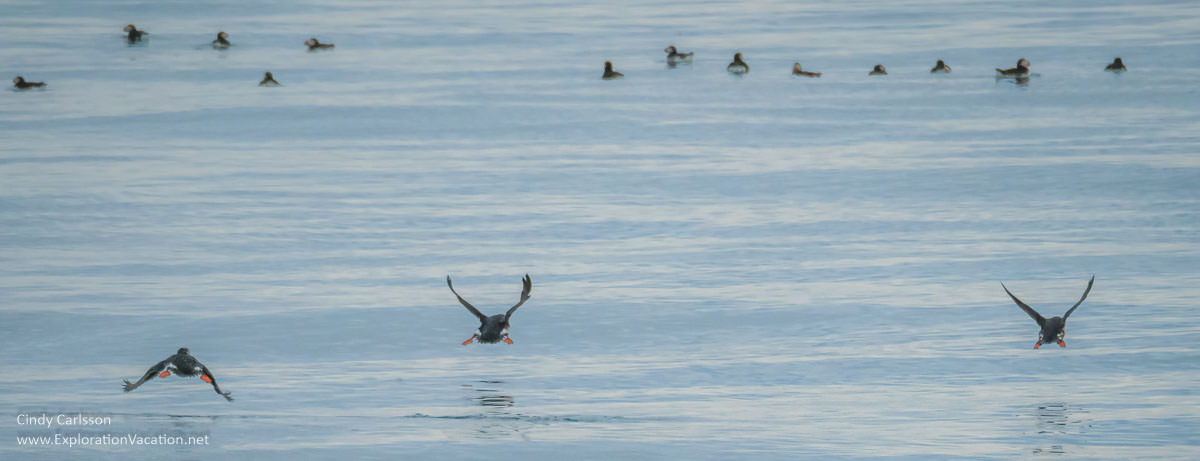
And plenty are close enough to easily spy on, though binoculars or a telephoto lens helps.

Because there are so many puffins here, we watch a lot of them take off and land on the sea. This is highly entertaining, as they do not easily make the transition between sky and sea.

Not that we only see puffins. There are many other birds – gulls, terns, murres, fulmars, ducks, and more.

On the lookout for whales
After floating amid the puffins, we head in the opposite direction in search of whales in Skjalfandi (Skjálfandi) Bay.

Husavik whale watching tours regularly spot humpback and minke whales, as well as white-beaked dolphins and harbor porpoises. Blue whales, the largest whales on the planet, are also regular visitors to Skjalfandi Bay, but don’t seem to make themselves visible to whale watchers as often. Lucky visitors might also see orcas, northern bottlenose, pilot, sei, sperm, and fin whales.
We see a handful of whales near our boat, and can see many more breaching humpbacks traveling away from us in the distance. But we have plenty of time to watch those nearest us, which include a mix of humpback, minke, and fin whales.
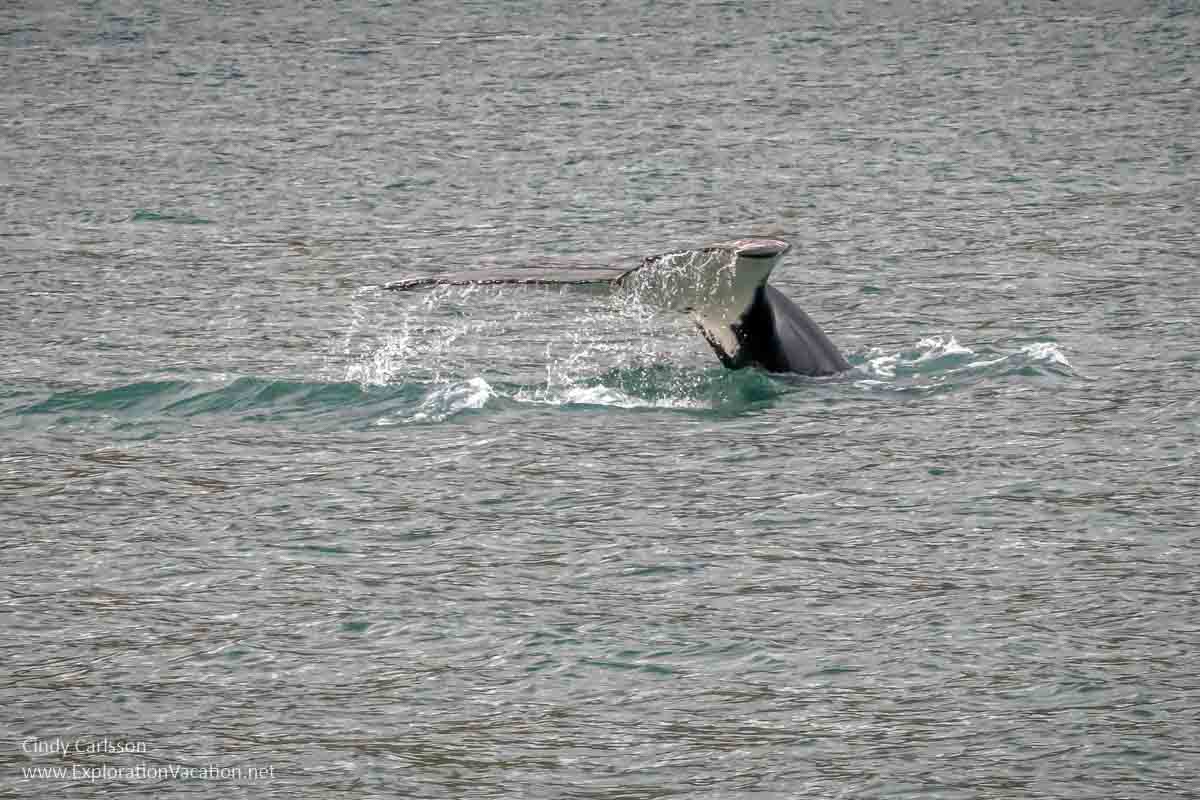
(That’s a humpback whale sliding back out of sight.)
There’s never enough time for whale watching, but tours only stay out for so long. Happily, as we turn toward Husavik, a few dolphins or porpoises join us momentarily.
Of course, I would have liked to see even more whales and a lot more breaching. Instead of dramatically leaping from the water, the whales we saw near the boat came up for air and then skimmed along the surface for a moment or two before disappearing again, sometimes with a final flip of their tail and sometimes not. (Neither minke or fin whales usually show their tails when diving, so all of the whales that let us see their flukes were likely humpbacks.)
However, even if we hadn’t seen any whales at all, the scenery would have made the trip worthwhile. Skjalfandi Bay is lovely, with towering mountains, waterfalls, and rocky outcrops festooned with roosting sea birds.
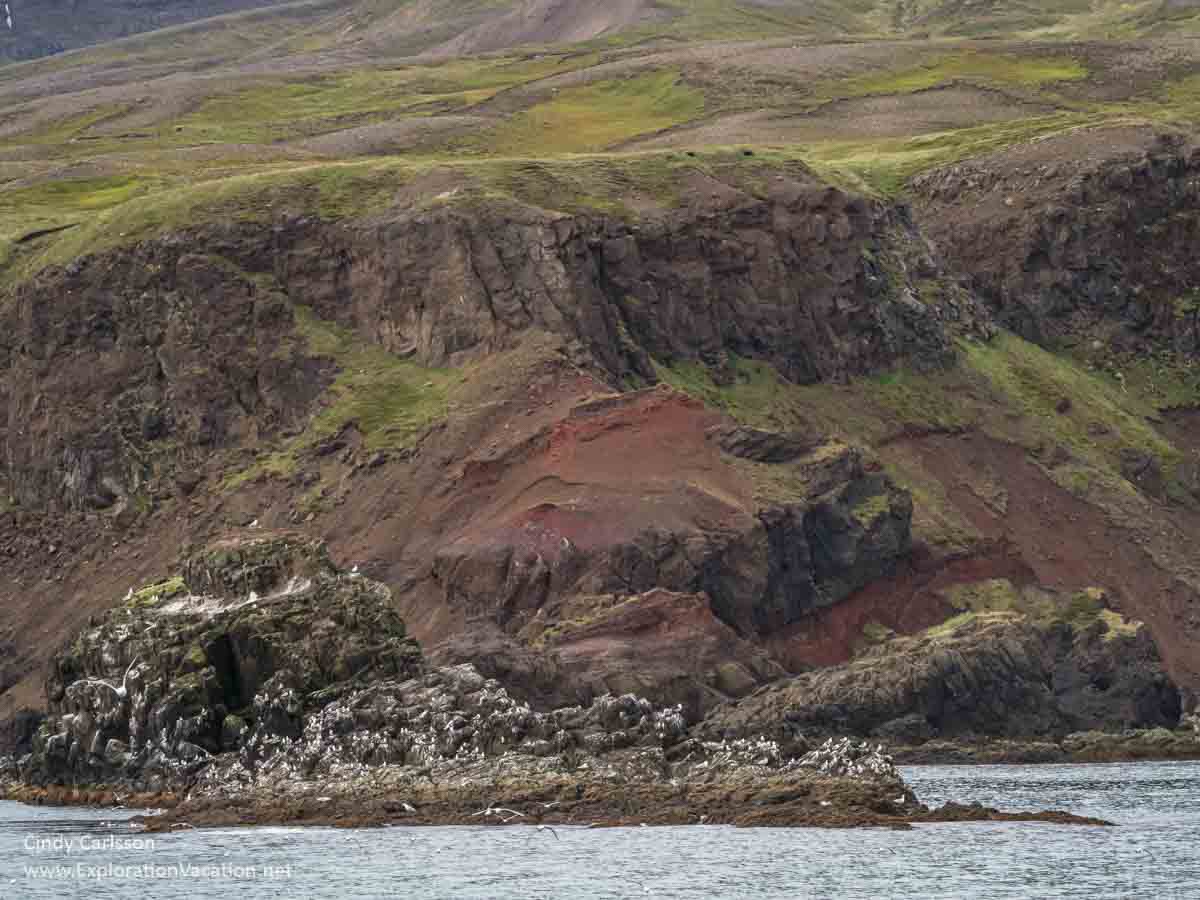


Where is the best whale watching in Iceland?
Although it seems there should be great whale watching all around Iceland, regularly scheduled tours are generally available only in an area that runs roughly from the southwestern coast near Reykjavik, north along the west coast, and then east along the northern coast to Husavik.
The greatest number of tours are based in Reykjavik and Husavik or Akureyri in the north. However, if you are willing to venture a little farther afield, you can find tours on the Snaefellsnes Peninsula, in the Westfjords, and at a couple other spots.
Some tours operate year-round. However, aside from those based in Reykjavik, most are seasonal.
And “best whale watching” means?
I identified Husavik as offering the “best whale watching in Iceland” based on the number and variety of whales you are might see, how likely you are to see them, and the range of tour options available. The best spot might be different if you can only visit Iceland at a certain time of year or have your heart set on seeing a specific type of whale.
For example, whale watching options are limited on the Snaefellsnes Peninsula. However, Iceland’s best winter and spring whale watching is probably found here because the odds of seeing orcas (killer whales) and sperm whales are much higher than elsewhere.
Of course, if you are only in Iceland for a short time, it’s best to do your whale watching right around Reykjavik. During summer you’ll have a good chance of seeing many of the same whales you would see in Husavik, as well as puffins. While there are fewer whales here in the winter, there are some. And there are other attractions. For example, North Sailing’s silent northern lights sail sounds magical with or without whales.
However, if you are traveling Iceland’s Ring Road, Husavik is the best place to go whale watching.
Why Husavik is the best place for whale watching in Iceland
Of all the places to go whale watching in Iceland, Husavik offers the best combination of lots of whales, of lots of kinds of whales, and a high likelihood of actually seeing some of them. It also has a variety of tour options, lots of birds, a pleasant downtown with a few things to do, and a relatively convenient location just off the Ring Road. If that isn’t enough, a number of other must-see stops are located nearby. All of these make Husavik the best place for whale watching in Iceland and an obvious addition to any Ring Road itinerary.
Husavik has lots of whales
Husavik offers the best whale watching in Iceland and some of the best in all of Europe.
Because Skjalfandi Bay has a healthy, thriving ecosystem, there is plenty of food available for whales. That’s why regular visitors include humpback, minke, and blue whales, along with dolphins and porpoises. (Humpback whales travel 4,000 miles each spring to feast at the bountiful buffet these waters offer.) But the area attracts other whales too. Depending on the season, whale watchers might spot any of a dozen or so of Iceland’s 23 species of whales, dolphins, and porpoises.
And you are more likely to actually see whales here than almost anywhere else in Europe. (Most years, at least 98% of Husavik’s whale watching tours spot a whale!) In addition, you’re likely to see seals and a wide variety of birds, including nesting puffins.
Husavik offers a tour for every taste
Husavik has a whale watching tour that fits the needs of just about every type of traveler. While I loved my tour with North Sailing, there are other options. These include more adventurous tours on much smaller speed boats, tours that feature sailing, tours that combine whale watching with another activity (bird watching, horseback riding, off-road touring, yoga, etc.), and more. And you are very likely to see a whale on any of them.
I went whale watching on a repurposed oak fishing boat. But adventurous travelers can zip over the water in a RIB (rigid inflatable) boat. And romantics can sail on an old-fashioned tall ship.
Touring on a RIB boat is ideal for thrill seekers and photographers. On the other hand, tours on tall ship or oak fishing boats are suitable for pretty much everyone. That includes travelers with mobility limitations and families with very small children – at least in good weather. With a little advance notice, tour companies using wooden boats will ensure that all visitors, including those in strollers or wheelchairs can join in the fun.
However, keep in mind that all tours in Husavik use boats with open decks and travel through fairly open water (Skjalfandi is a very large bay). Tours from nearby Akureyri operate in Eyjafjord (a long, sheltered fjord) where the water is generally calm. In addition, one company there has a tour boat with an enclosed gallery that allows whale watching from inside through large windows. It lacks the charm and heritage of wooden boats, but offers a bit more comfort and security in unpleasant weather.
There are other things to do in Husavik
Husavik isn’t a very big town (Akureyri is much larger), but it’s a pleasant place. And Husavik has enough things to do and places to eat to make it worth hanging around for a while.
Take time to wander along the harbor and admire the many kinds of boats you’ll find there.

The Husavik Whale Museum is a natural addition to any whale watching tour. (And there are often discounts for combining a whale watching tour and museum visit.) The museum exhibits 11 whale skeletons, including a blue whale. There are also art exhibits and exhibits on whale biology and evolution, the history of whaling in Iceland, and more.
Architecture buffs will want to take a look at Husavik’s unusual wooden church. It was designed by a noted Icelandic architect and built in 1907 using wood imported from Norway.

It’s worth stopping to take a look inside too.
Just outside town, the GeoSea baths sound wonderful. Located on a cliff above Skjalfandi Bay, visitors can enjoy steamy geothermal pools while watching for whales in the bay below.
Husavik is an easy detour off the Ring Road
Husavik is a relatively short detour off the Ring Road. And it’s a pleasant drive through the Icelandic countryside.
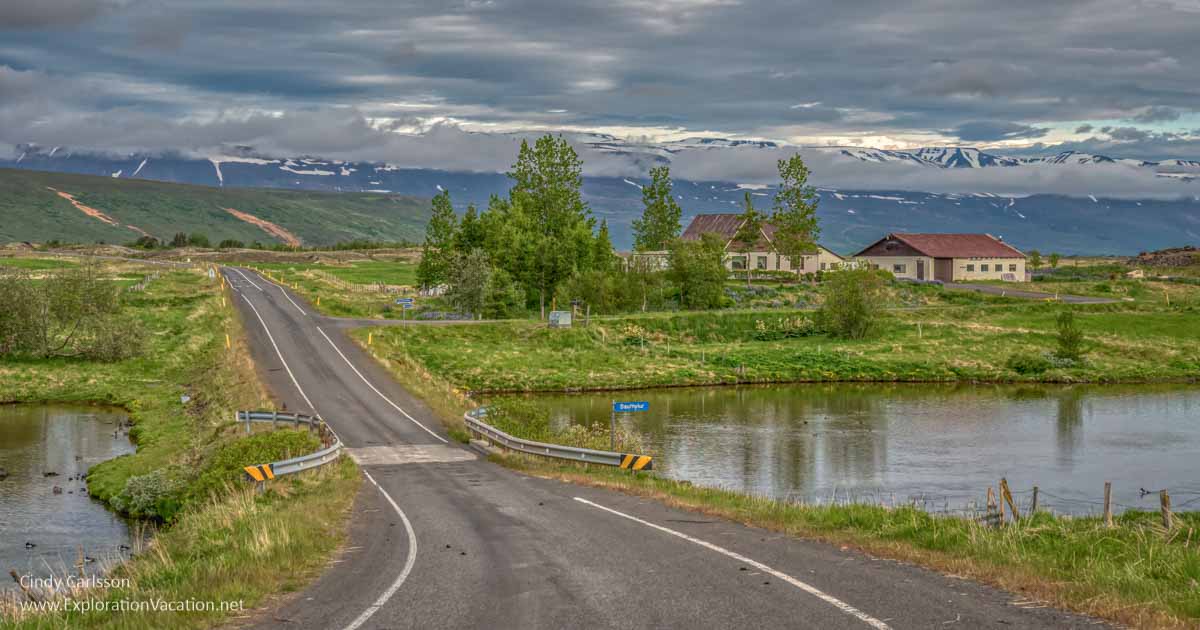
Because it is so close to the Ring Road, you can take a break from driving for a whale watching tour and then continue on your way. Or, better yet, you can spend the night or two exploring the in the area around Husavik.
Husavik is a good base for exploring the area
If you don’t want to change lodging every day, pick a spot in or near Husavik and stay a few days. This gives you time to go whale watching, hike around Myvatan, and watch the water roar over Godafoss.
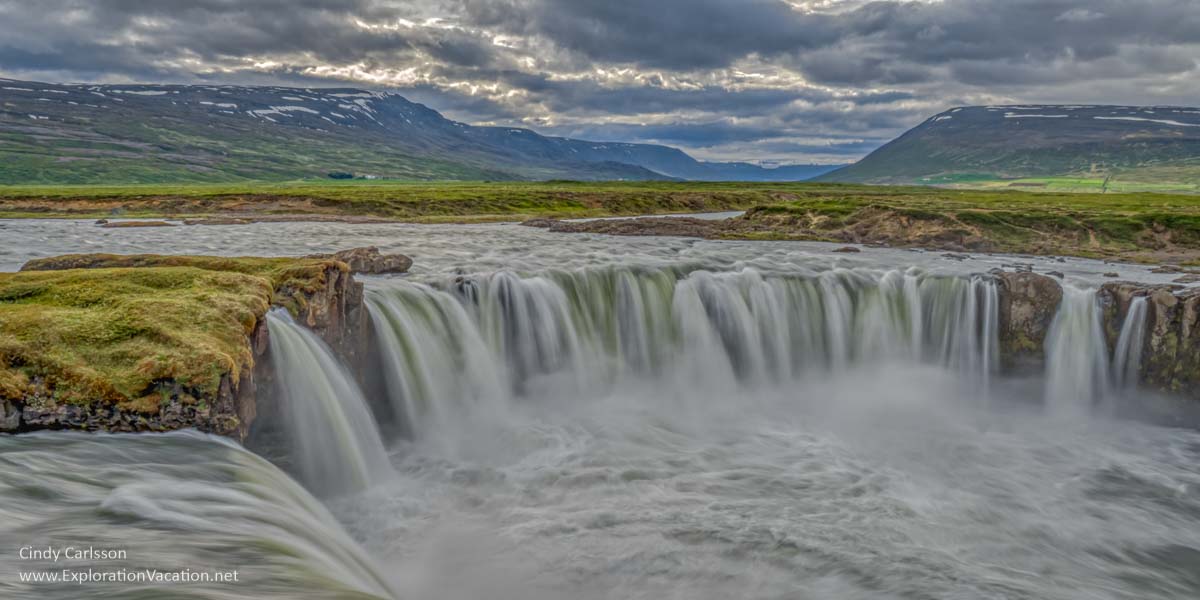
There is also a fabulous looking historic turf farmstead near Husavik. Thvera (Þverá) in Laxardalur is part of both the National Museum of Iceland and a proposed UNESCO listing that includes a number of turf houses, farm buildings, and churches in Iceland. However, it’s unclear to me whether or not it is ever actually open to the public.
North Iceland Tourism has a designated tour route through this area called the Diamond Circle. It will take you through to some of the best sights and activities in the area.
Plan your Husavik whale watching trip
Located on the northern coast of Iceland, Husavik (Húsavík) a pleasant little town that offers the some of the very best whale watching in Iceland.
How do I get to Husavik?
While I’m always up for a road trip, it is possible to reach Husavik from Reykjavik by bus and air, as well as by automobile.
Drive to Husavik
Husavik is an ideal stop for travelers driving along Iceland’s Ring Road (Highway 1). Weather and road conditions permitting, it’s possible to get there from Reykjavik in under six hours. The road is paved the entire way, but much of the area is very isolated, so bring snacks and beverages with you.
There are places to buy fuel along the way, but check your gauge before you start out because it can be a long distance between gas stations.
We visited Husavik on the second day of our Ring Road tour, having spent our first night in the Sagafjord area.
Other options for getting to Husavik
While Ring Road tours may stop in Husavik, some do not. If you plan to book a tour on the Ring Road, but really want to go a whale watching in Husavik, check with your tour company to see what arrangements they have. Most probably include whale watching somewhere, but it might not be in Husavik.
There is regular bus service between Reykjavik and Husavik via Akureyri. However, it’s at least a 9-hour trip.
Gentle Giants whale watching in Husavik will arrange flights from Reykjavik for whale watchers. But you can also book a flight from Reykjavik (RKV) to Akureyri (AEY) yourself. From there, either rent a car for the hour drive to Husavik or spend 1½ hours on the public bus.
When is the best time for whale watching in Husavik?
In Husavik, whale watching season traditionally runs between May and September. However, in recent years April and October have also been good. You are almost guaranteed to see a whale of some kind during the summer months, but some species are usually found earlier or later in the season.
There are no whale watching tours in Husavik during winter. (Reykjavik is the best alternative for winter whale watching.)
North Sailing offers northern lights trips in December and again in early spring, based on demand and weather.
There is no best time of day for whale watching
While I prefer morning or evening whale watching tours, there really isn’t any time of day when whales are more likely to be active.
However, if you take North Sailing’s Puffin and Whales tour, be aware that morning light on Puffin Island is terrible. That’s because you don’t actually circle the island (at least, we didn’t), forcing you to look east toward the rising sun – which puts both nesting sites on the island and birds in the water around it in deep shade. You can see the birds, but photographing them is pretty much impossible no matter how good your gear is. If you really want to see and photographs birds at their nests, do this trip in the afternoon.
On the other hand, morning brought gorgeous light to the mountains around Skjalfandi Bay. But then, there are mountains in several directions, so any time of day should be lovely if there is some sun.
Husavik whale watching tour companies
Whale watching tours are offered by several companies in Husavik. Private tours, fishing tours, and a variety of combination tours are also available from all of them.
North Sailing
We chose North Sailing in because of its classic wooden boats and combined puffin and whale tour. But there are a lot of things I like about this family-owned company, including their sincere commitment to tradition, sustainability, and responsible tourism.
Family-run North Sailing began Husavik’s first whale watching tours in 1995. Since then, they have continued to expand and innovate. At the same time, preserving traditional wooden boats and Iceland’s maritime heritage is at the very core of their business. Thus, all of their tours use traditional boats that have been carefully restored and converted to carry passengers. The fleet includes six traditional Icelandic oak fishing boats converted for whale watching. They also offer a variety of trips on four schooners, an old-fashioned type of tall ship. (These are the only ships like this regularly sailing in Iceland.) And, in order to offer silent tours, one fishing boat and one schooner have hybrid electric motors.
North Sailing offers four types of regularly scheduled whale watching tours out of Husavik. Both the Original Whale Watching and Whale Watching and Puffins tours use traditional motorized Icelandic fishing boats like the one I was on. The Whale Watching and Sails tour uses a wooden schooner. And, naturally, the Silent Whale Watching tour uses the oak fishing boat with an electric engine.
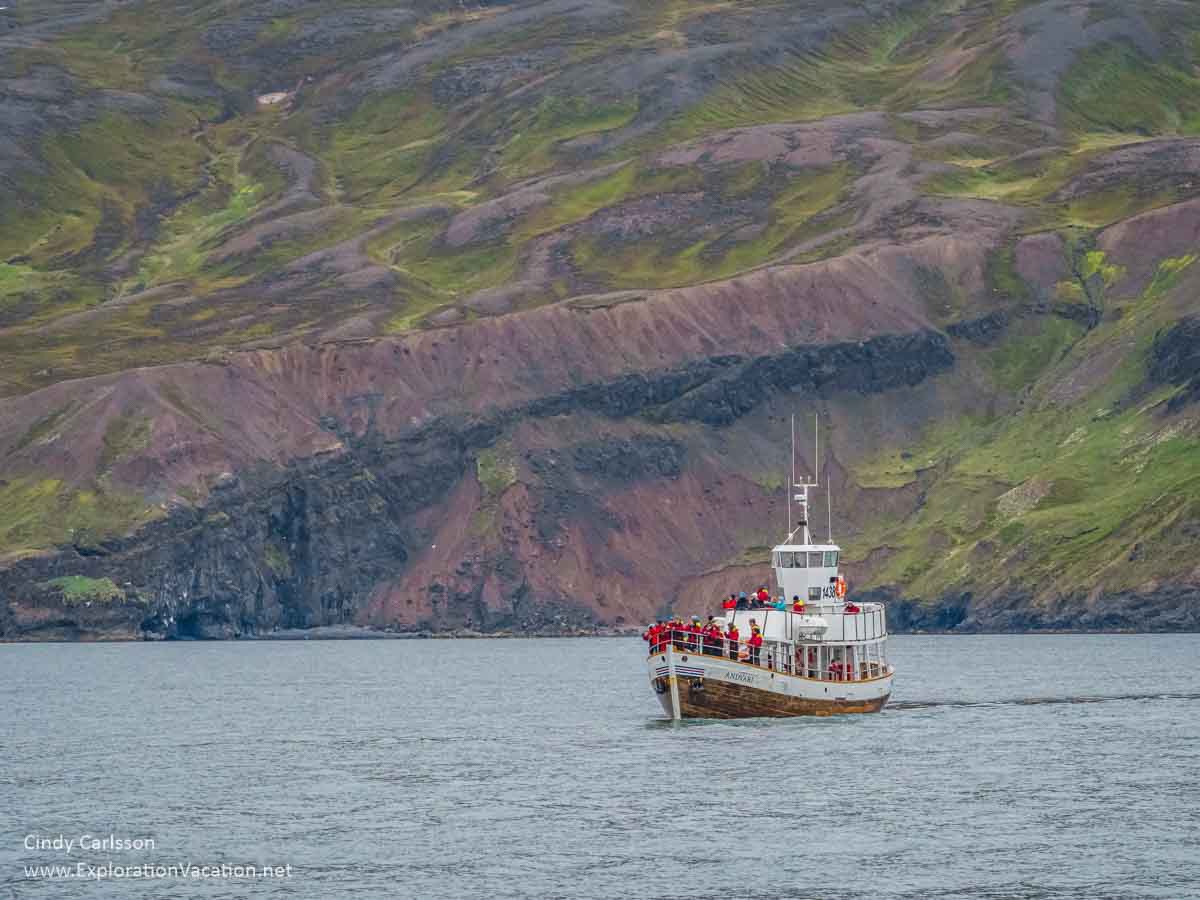
All tours include a professional naturalist. They also include a complimentary hot chocolate and a tasty cinnamon roll.
North Sailing also runs a whale watching tour from nearby Hjalteyri. And, like other companies, they offer options that combine whale watching with horseback riding. Private tours are also available.
At the beginning and end of winter they offer northern lights tours out of Husavik. They also offer an absolutely magical-sounding northern lights silent sail on a tall ship out of Reykjavik from October thru April.
If you want to explore more of Iceland’s Arctic coast and islands, consider North Sailing’s three-day sailing adventure on their hybrid electric schooner. Or check my dream trip, a week exploring east Greenland aboard a traditional sailing ship.
Gentle Giants
Another family-owned operation, Gentle Giants offers scheduled and private tours on a fleet that includes a couple of traditional oak fishing boats (like the one I was on with North Sailing), rigid inflatable (RIB) speedboats, and a fiberglass fishing boat.
Besides the usual whale watching and puffin tours, they also offer fishing, sea kayaking, and a variety of other activities.
Although I don’t recommend visiting Husavik as a day-trip from Reykjavik, Gentle Giants offers that option.
Salka Whale Watching
Salka Whale Watching (very slow loading website) is another family business. They operate two traditional oak boats that take visitors on whale watching and whale and puffin tours. They also offer a combination whale watching and horseback riding tour.
Husavik Adventures
Unlike the other companies, Husavik Adventures doesn’t use oak fishing boats at all. Instead, it uses two custom RIB speedboats that seat 12 passengers each. Along with whale watching, Husavik Adventures offers a combined buggy and whale watching tour that includes an off-road vehicle trip in Myvatn.
Although they promise to practice responsible whale watching, they are the only whale watching company in Husavik that doesn’t mention participation in other responsible whale watching and tourism activities or organizations.
Choose the right tour for you
Almost every whale watching tour out of Husavik (especially during summer) will see a whale and at least a few porpoises or dolphins. So, don’t waste a lot of time comparing each company’s sighting rate. (Which don’t tell you much or differ significantly anyway.) Whether or not you see a whale will depend largely on the time of year you visit, not the tour company you choose.
And keep in mind that “seeing” a whale usually means seeing its back as it skims along the water and, sometimes, a flip of its tail as it dives. Even when very close to your boat, you may not see a lot of the whale itself. While whales do breach, they don’t often go flying up into the air. It happens, but more often they just break the water’s surface.
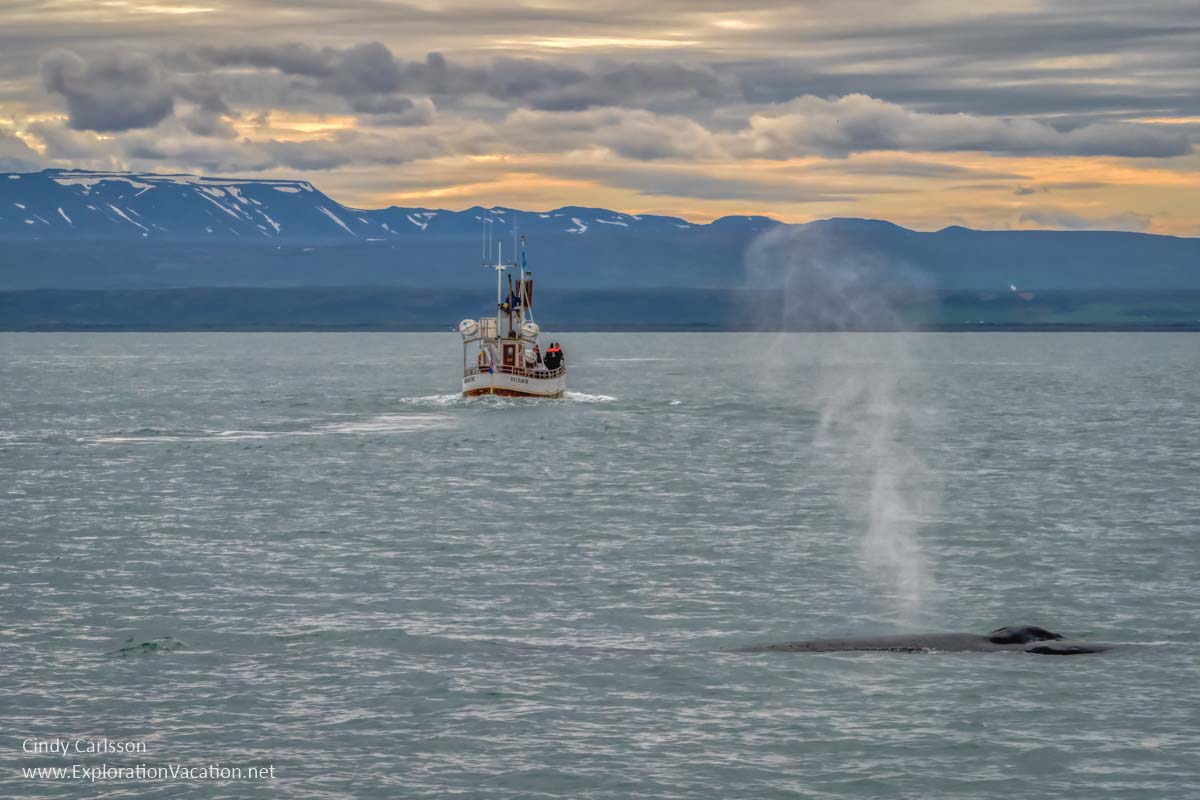
Fortunately for both researchers and whale watchers, humpback whales (and there are a lot of humpbacks in Skjalfandi Bay) usually flip their uniquely patterned tails up into the air as they dive.
So, given your likelihood of seeing a whale is about the same with any tour company, how do you choose the best whale watching tour for you?
How important is just seeing a whale?
Are you only booking a tour because you want to see a whale or are you ok with just seeing a range of marine life and enjoying the scenery in Skjalfandi Bay?
If all you care about are whales, consider a tour on a RIB speedboat. These highly maneuverable speedboats quickly zip to wherever whales are sighted. That allows them to travel farther, potentially reaching areas beyond the reach of slower wooden boats. But, again, in Husavik you are very likely to see a whale on any type of boat.
On the other hand, if you want to see whales, but also want to see birds and enjoy some great Icelandic scenery, choose a tour on one of the classic oak fishing boats.
Or, if it would be nice to see whales, but you are mostly just looking for some time out on the water, book a sailing trip on one of the wooden tall ships.
How important is getting a really good picture of a whale?
If you really want to see a whale up close and at eye level, RIB (rigid inflatable) speedboats are the way to go.
To get the best photos, you want to be face to face with the whales at sea level. Not looking down on them from the deck of a boat. In a RIB, you are right at water level. If a whale surfaces near you, you can look it straight in the eye. And, because they only seat 12 passengers, there shouldn’t be anyone blocking your view!
But these boats have a downside too. Because you are so close to the water, you only have a really good view of nearby whales. And, since whales will swim up to boats of any size, it’s not a given that more whales will come near a RIB boat then a larger one. That means whale watchers on bigger boats have a much better view of whales farther from the boat. Thus, they are likely to see MORE whales, they just won’t very close to all of them – and they won’t be at eye level with any of them.
How important is comfort?
How comfortable do you want (or need) to be on your whale watching trip? And, perhaps more importantly, how comfortable are you on the water?
In general, motorized oak fishing boats and sailing ships offer the greatest degree of comfort for most people. Although “comfort” is relative here. All of these boats have open decks and none have particularly comfortable seating. Nor do they all seem to have enough seating for everyone. However, all offer a few spots where you can get out of the wind. They also have toilets. Finally, and perhaps most importantly, passengers can easily move around the deck at any time in most weather. Sturdy side rails not only make it safe to stand while the boat is moving, but give would-be photographers a place to steady themselves and their gear.
In addition, with a bit of advance notice, families with strollers and wheelchair uses can be accommodated on any of the traditional wooden boats.
On the other hand, RIB boats have a separate seat for every passenger. (They have to, since passengers have to be seated while zipping along.) However, these boats are small, fast, and completely open. That makes traveling in them particularly cold and potentially very wet. There’s no place to escape the wind. And there’s no toilet on board either. But they are far safer than they look and great for adventurous travelers with the right clothing and no fear of being bounced around on open water in very a small boat. (I would happily take one of these tours, and I’m not the adventurous type. They look cold, but not dangerous or scary.)
But the most important factor is your own level of comfort on the water. If you are nervous on the water or generally avoid boats, choose a classic oak fishing boat. You’ll be a comfortable distance from the water and the boat’s motion will be more consistent than that of a schooner or RIB boat.
Do you get sea sick?
No matter what boat you book, if you are at all subject to motion sickness, take an effective medication to prevent nausea BEFORE you board.
Don’t assume you’ll be fine just because it is calm in the harbor. It may not be calm farther out or the wind may increase during the tour. Use something that won’t make you tired and there should be little downside to taking it even if it turns out you didn’t need to. (I use Bonine, which is a brand name for Meclizine. Unlike some other things I’ve tried, it works well for me without causing drowsiness or other side effects.)
For most people subject to sea sickness, the motorized oak fishing boats are the best bet for avoiding nausea. And don’t be fooled by how graceful tall ships look. Sailing can be surprisingly nausea inducing. For a true tail of just how nauseating, check my friend Rachel’s story about her trip aboard one of North Sailing’s schooners.
How important is tradition?
Fishing (and whaling) were a way of life in Iceland for generations. But those activities were supported by highly skilled craftsmen who developed and built the oak fishing boats now used by whale watching tour companies in Husavik.
The art of building such boats is being lost, as are the boats themselves. Companies that use these boats help keep those skills alive. Touring with them is a way of actively engaging in a bit of Icelandic history while ensuring that this bit of the past survives well into the future.
Support responsible whale watching
Iceland doesn’t have a lot of regulations in place when it comes to whale watching. That’s probably not surprising since it’s a country with a long history of whaling. (While whaling may finally be coming to an end in Iceland as it becomes an increasingly unprofitable, both whale and puffin are found on tourist menus throughout the country. Please don’t eat them for dinner!) But even if it isn’t required, following responsible whale watching practices is important.
The Icelandic Whale Watching Association (IceWhale) promotes whale watching, research, and conservation. Their Code of Conduct promotes responsible whale watching that minimizes stress on these magnificent animals.
For the most part you don’t have to think too much about this if you book a tour in Husavik. All four whale watching tour companies claim to follow IceWhale’s code of conduct. And, with the exception of Husavik Adventures, all are members of IceWhale itself.
North Sailing seems particularly engaged when it comes to sustainability, responsible tourism, heritage travel, and responsible whale watching.
Gentle Giants’ association with a range of responsible tourism and whale watching groups also seems to indicate a sincere commitment – even as photos on their website tell a different story. (Please do NOT pet the whales.)
On the other hand, Husavik Adventures claims to operate in line with IceWhale’s code of conduct, but without being a member or (apparently) participating or engaging in other responsible tourism, whale watching, or conservation activities and organizations. If you book with them, do a little research on responsible whale watching to educate yourself. Then, when you board, ask how they avoid disturbing the whales and support marine mammal conservation. That puts them on notice: You expect them to operate responsibly.
Responsible tourism is about more than whales
Whales face a whole range of threats. However, that’s true of Iceland’s environment overall. To promote responsible tourism in Iceland, visitors are asked to take the Iceland Pledge. While specifically aimed at problems faced by Iceland, they are a good guide for travelers in anywhere.
Booking your tour
Here are a few tips for booking your tour, including costs, cancellation and refund policies, and more.
How much does whale watching cost?
Nothing in Iceland is cheap, and whale watching tours are no exception.
Expect to pay at least $75 USD in 2021 for a standard tour on an oak fishing boat. Prices are higher for longer tours and tall ship sailing cruises. Because they are limited to 12 passengers at a time, prices are much higher for RIB boat tours. A few short specialty tours may be less. Some tickets may include a discount at the Whale Museum or a local café or shop. (Several whale watching companies own other businesses as well, so they may offer discounts to encourage visits to all of their businesses.) If tourism is still down next year, prices may drop some, but don’t expect big discounts.
Which tour offers the best value for your money will largely depend on what is and isn’t important to you.
Do I need to book in advance?
Advance reservations are a very good idea if you are traveling in June, July, or August. They are usually essential during this time if you want to book a RIB boat tour.
Fortunately, you can change the date or time of your reservation without charge if you do it at least 24 hours in advance and space is available on another tour.
Refunds are also available should you need to cancel your reservation completely. However, with very limited exceptions, refunds are not available for cancellations within 24 hours of your tour. If you think you might have to cancel, read the terms very carefully before booking.
When is the best time to see whales?
Summer is the best time for whale watching in Husavik. This is when the greatest number of whales are around. However, different species move through in different seasons. Blue whales, for example, usually visit the bay in early summer before heading farther north.
There is no best time of day to see a whale. Whales are unpredictable and their movements change from day to day.
Tours run rain or shine (unless the weather is really bad)
Just as there is no best time of day for whale watching, there is no best weather for whale watching either. Whales don’t care what the weather is like. Rain might bother you, but it doesn’t bother the whales.
Whether you book in advance or not, keep an eye on the weather forecast during the week leading up to the date you plan to go whale watching.
If you find a date with dry weather, that’s the day to either book your tour or try rebooking your original reservation. (As long as you change the date of your booking more than 24 hours in advance, there usually isn’t a charge. But there has to be space available on another tour too.) Also keep in mind that you want calm or no wind if you are on a RIB or motorized fishing boat, but will need some wind if you want to actually sail (instead of just motoring) on one of the schooners. And, of course, Iceland’s weather tends to be unpredictable, so don’t be surprised if the forecast turns out to be wrong.
(I knew I would be around Husavik for two full days, so booked my tour only a few days in advance. That let me book a morning tour on a day predicted to be dry and calm in the morning, with increasing wind as the day went on. And that was exactly what we got. It was very calm for most of my tour, but it was already a lot windier by the time we got back to Husavik – which meant North Sailing’s schooner was sailing along beautifully.)
Avoid stormy weather if you can, but don’t worry too much about getting caught in dangerous conditions. If the weather is rough enough to be dangerous, your tour will be cancelled. Should that happen, your tour company will book you on another one of their tours or return your money.
Book your tour directly
There are tons of third-party online booking platforms that offer whale watching tours with these same companies. Don’t use those. You can book any whale watching tour in Husavik (and probably any other whale watching tour in Iceland) online directly with the tour company itself.
Booking directly helps both these small businesses and the local economy in general. And shouldn’t cost you any extra. (It’s often cheaper.) Most importantly, when you are in direct contact with the tour company from the beginning, you’ll be sure to know if there is a last-minute schedule change or weather-related cancellation.
There is no guarantee you will see a whale.
While all the tour companies in Husavik seem to sight a whale over 98% of the time, it’s never guaranteed.
However, if you are on a tour that doesn’t spot any whales, all Husavik whale watching companies will let you go out on another tour for free. Just don’t expect a refund.
The day of your tour
No matter which whale watching tour you book, they will do everything they can to make your tour a success. But there are a few things you can do to increase the odds of having a great tour.
Check the weather
Take a look at the forecast just before leaving for your tour. It’s always possible that the storm you were trying to avoid moved in early or that the morning’s sunshine is going to turn into rain in a few hours. Plan accordingly.
It will be colder than you expect
No matter how pleasant the weather seems, it will be colder than you expect.
This is Iceland. Even at the height of summer, it isn’t going to be hot. And it will be much colder out on the water. Besides, if the water weren’t cold enough, there’s always the possibility of a cold wind.
While most companies will provide foul weather clothing, dressing warmly is still essential. And don’t forget warm gloves and a hat or ear muffs!
Don’t be late
All tours run on a set schedule. If you are late, you may very well miss your tour and the tour company is under no obligation to put you on another one
Prepare for sea sickness
If you suffer from motion sickness, take your medication before you head to the dock.
Bring a waterproof camera bag
While most camera gear today has some level of waterproofing, salt water can cause serious problems. That makes a waterproof bag for your camera and/or phone essential when touring on a RIB boat, but it’s a good idea on any kind of boat.

